Feb 16, 2024
Article
Academy
Selling Beats
Email marketing is probably the most underrated and underused marketing strategy to sell beats.
If you ask the average producer advice about marketing strategies to sell beats. The most common responses you’d get are…
“Start a YouTube channel!”
“Post your beats on Instagram”
“Build a following on Twitter and Facebook”
“Sign up with BeatStars or Airbit!”
But when you start following their advice, you’ll soon notice that it’s not that easy to get your beats on the top search results of YouTube. It’s not that easy to turn likes and comments on SoundCloud into sales.
And Twitter… Really? Is that still working?
Even when you get plays on your beat store. How are you going to turn those ‘listeners’ into customers?
As a result, you’re not selling beats. You’re trying your hardest but you can’t seem to crack the code on how to sell beats online.
Or, perhaps you’re stuck on a certain number and there’s no growth in your business.
Luckily, there’s another way to sell beats and it’s called Email Marketing.
You might be thinking: “Oh yeah, that’s nice! I can update my email subscribers with my latest beats. Dropping new heat in their inbox every week, right? 🔥”
Frankly, this is what most producers consider email marketing (not even talking about a minority of producers trying to buy rapper email lists 😅)
While this isn’t wrong, they’re missing out on a much bigger opportunity. Email marketing is more than sending artists your latest beats and dropping discount codes for every generic reason you can think of.
Forget the ‘Summer Sales’, ‘Easter Sales’, ‘4th of July Sales’, ‘Christmas Sales’ and ‘Your Grandmother’s 85th Birthday Sale’.
We’re going to take email marketing to the next level! Beyond your seasonal discounts and self-promotion.
Here’s what we will cover in the next sections:
Part 1: Why email marketing is (still) relevant for selling beats
I’ve been using email marketing since 2014. Over the years, I’ve read a dozen books about copywriting, structured communication and persuasion marketing. It’s definitely a fun game to play! 🏆
What’s most interesting is that I’ve been using email marketing to generate at least 30% more sales every year.
In 2017, more than 30% of my sales originated from returning customers. Together they cover for thousands of extra dollars of yearly revenue.
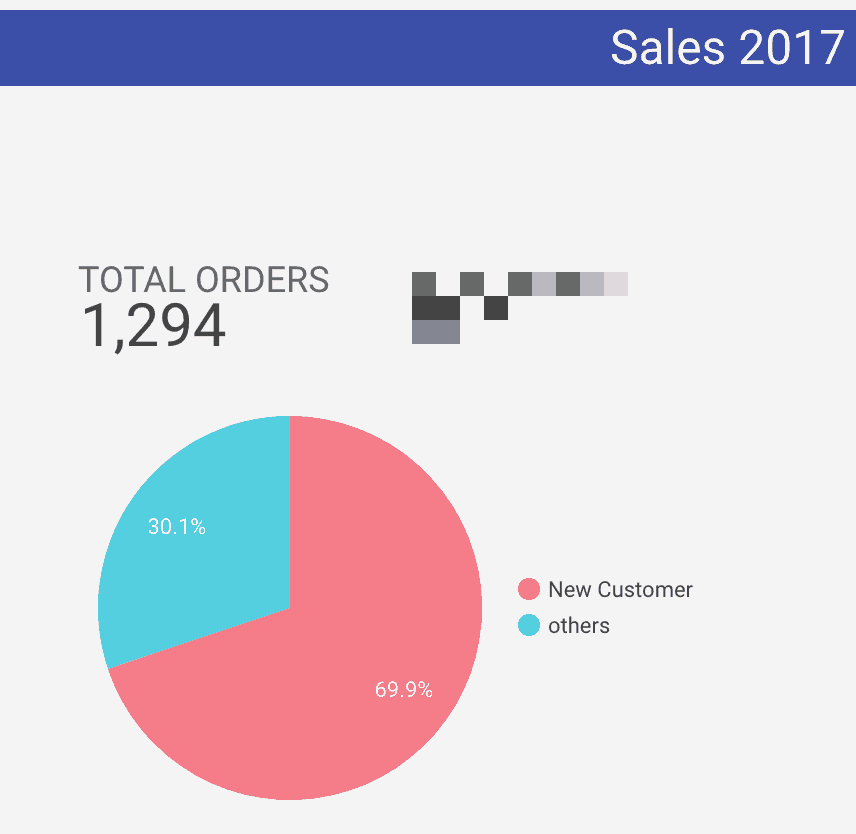
Sales 2017 from my Google Data Studio
The possibilities blew me away once I really got into it.
The thing is, these artists you’re trying to sell beats to are writers. Writers are creative people and creative people are more emotional. Which makes them the perfect audience for your persuasion marketing campaigns.
I’d like to add that persuasion marketing has nothing do with ‘taking advantage’ of people. With persuasion marketing, we apply what we already know about human psychology. We only use that knowledge for creating techniques to sell beats. At the end of the day, it’s all about creating a ‘win-win’ situation.
Why every producer should use email marketing
It’s no secret that the beat selling industry is an oversaturated market. With all the competition, it has never been more important to make your mark in this industry.
The quality of your music is just as important as your qualities as a businessman and marketer.
In our niche, we have to share our target audience with thousands of other producers. So you better make sure you stand out from the pack.
The famous quote: “Where words fail, music speaks” won’t get you really far here.
The personal touch you can add to a simple email can make the difference between pushing artists away or pulling artists closer to you.
Whenever an artist is in need of beats, YOU should be the first person that crosses their mind. If you’re not putting in your best effort to become that person, you will have a hard time standing out from your competition.
Some of my best customers spent more than $1,000 on my beats. And I’m not talking about exclusive rights. I’m talking about customers that have placed $30-140 orders over and over again.
I have never met these people in person. Most of them, I have never had an actual conversation with. We never spoke on the phone or on Facebook or Instagram direct messenger. We only communicated via email.
However, after a few weeks, I knew more about these people than I knew about any new follower on my Instagram account.
The key to every successful business is knowing and understanding your target audience.
What’s on their mind? What are their goals? What are they struggling with?
To finally be able to answer the most important question: How can you help them?
“If I was down on my last dollar, I would spend it on public relations”
– Bill Gates
Email marketing vs. Social media
I’ve talked to several online producers in our Facebook Group “The Art Of Selling Beats”. Some of them were struggling to get any sales at all. And some of them were tired of not seeing their business grow.
When I asked them about email marketing, I noticed I was getting similar responses.
“No, I use Instagram. I have about 30,000 followers”
“I tried, but open-rates and click-rates are decreasing. I wonder if email marketing is still working?”
“Yes, I send weekly updates with new beats uploaded to my YouTube channel”
This tells me that the beat-selling industry lacks knowledge and experience when it comes to email marketing.
Before we dive deep into the rabbit hole, I want to get the following out of the way first.
Social media and email marketing are two completely different marketing strategies. It’s like comparing apples to oranges.
Probably the biggest difference is that you’re in charge of your email list. Once you’ve built an email list, no one is going to take that from you.
What if your Instagram account gets shut down or hacked? What if Facebook changes their policy and it gets harder to get your beats on people’s timeline?
With email, you decide when you want to show up in someone’s inbox.
Both Facebook and Instagram use algorithms that determine whether your posts are shown to a user or not. In other words, if Instagram doesn’t think your post is relevant for a user, it will not reach their timeline.
Email is also more personal compared to Social Media. At least, if you do it right.
This doesn’t mean that you shouldn’t be using Instagram, Facebook or YouTube anymore. On the contrary, you need these platforms.
These are great for directing traffic to your beat selling website. And on your website is where you’ll try to get artists to sign up for your email list.
Part 2: The basics of email marketing
First, let’s go over the basics of email marketing. Just so you know what I’m actually talking about in the next sections of this article.
When I talk about email marketing, I’m talking about building relationships with (potential) customers using personalized emails. The ultimate goal is to either convert a new subscriber into a customer or increase the lifetime value of a customer.
Obviously, I don’t manually email every single subscriber myself. That’s what we have Email Service Providers (ESP) for. Such as MailChimp, AWeber, ActiveCampaign or MailerLite.
There are two ways of sending emails.
One-Off Campaigns (manual)
Automations (automatic)
One-Off Campaigns
One-off campaigns are also called email blasts. It basically means sending a single email to a segment or all of your subscribers. For example, sending an update about a new beat you released yesterday.
Automation
A sequence of emails that are pre-written and scheduled to send every 2 days, every week or whatever time-schedule is relevant for the type of automation.
For example, introducing a 3-day discount (e.g. Buy 1 Get 1 Free ) through email and following up on that offer every single day at 4 PM.
Lead
Every new person that signs up for your email lists is called a Lead. Someone that has the potential to become a customer one day.
Open-rate
The percentage of people that open your email.
Nurturing
The process of preparing someone to receive your sales offer is called nurturing. A common phrase used in internet marketing which is also known as ‘Drip Marketing’.
This is NOT how you do email marketing
I’ve seen a lot of producers trying to do email marketing but most of them fail. In case you’re wondering. Yes, I sign up for producer’s email lists to spy on them! 🕵
This is not the way you do email marketing:
Sending email blasts with the sole purpose of making sales
Sending emails only when you’re doing a sale
Buying a list of email addresses and use that for your own business
Scraping emails of the web and randomly email people
Manually sending an email to 500 addresses in BCC.
Especially when sales are going slow, it can be tempting to buy a list of email addresses from other producers. It’s sad that producers even offer to sell this information. Besides the fact that it is illegal.
Nonetheless, it’s worth jack sh*t! 👎
''You’re getting off on the wrong foot when you send a random email to someone that has no idea who you are. Email marketing is about building relationships.''
Besides the fact that this person is probably going to unsubscribe from your list. You don’t want to get a bad sending reputation for sending spam emails. And this is what a lot of producers don’t know.
Everytime someone reports your email as spam, your sending reputation gets worse. As a result, future emails, even to people that actually subscribed to your list, will end up in their spam box.
This affects your open-rates, thus your sales.
How to get artists on your email list
There are many ways to get artists to sign up for your mailing list. But let’s be real, no one signs up for a “monthly newsletter” anymore.
To get them to sign up for your list, you need to offer them a bribe! (Other terms you may hear are: Lead magnet, content upgrade, bonus content, freebie etc.)
On my homepage, I give away 30 free beats. Ridiculous, right? Almost too good to be true.
Well, that’s exactly what you want. Make an irresistible offer almost too good to be true. One that they can’t refuse.
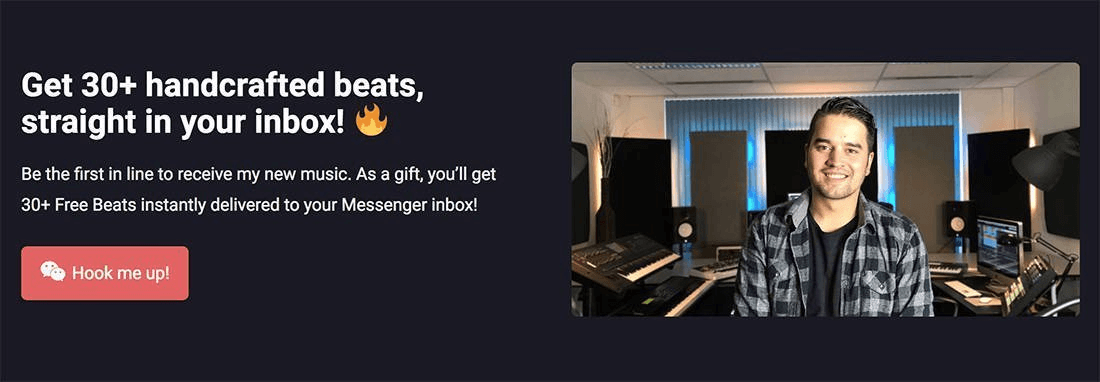
These 30 free beats are all tagged and in MP3 format. But surprisingly, I don’t get many complaints.
A lot of artists don’t care about the tags or quality. Those who do will end up buying a license anyway. On top of that, I provide a lot of value once you are on my list and inside my email automations
There are various ways you could get people to sign up for your email list. A few examples are free beats licenses, discount codes or educational content.
To increase the chances of artists signing up, you can run Facebook ads to promote your lead magnet to a wider audience. But that’s an article for another time. 😉
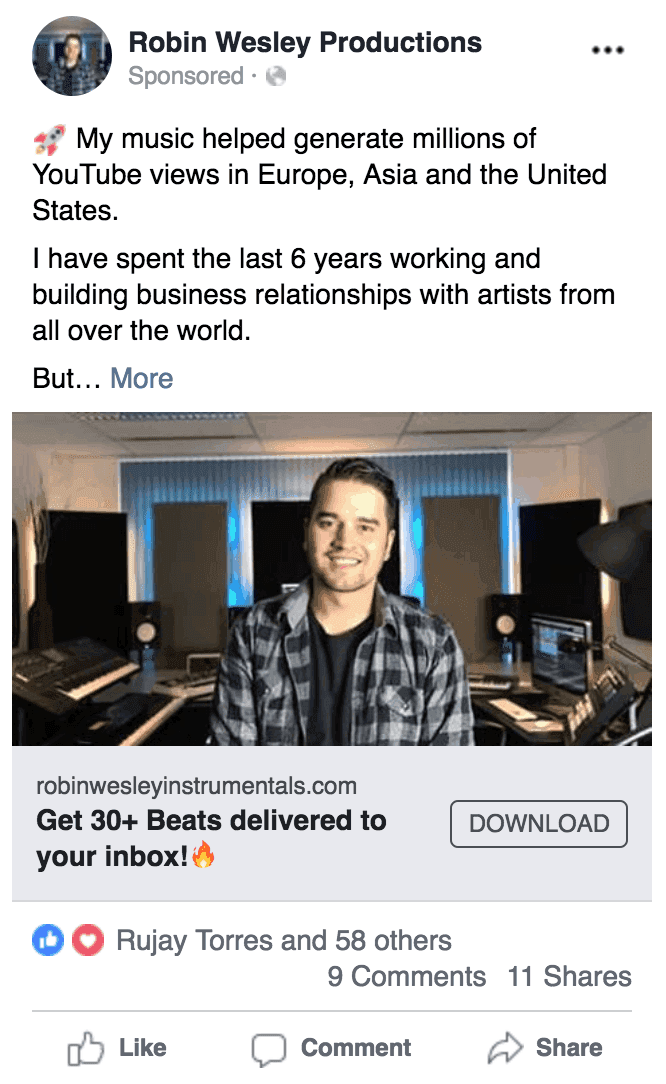
Part 3: Maintaining and managing a clean email list
Once you have artists sign up for your email list, the fun starts! You can start nurturing your leads and convert them into paying customers.
Hold up, champ! ✋There are a few crucial steps that go before this.
Maintaining and managing a clean email list is crucial for email marketing. It’s about having a high-quality list. Rather than having a high-quantity list.
I’m sure you’ve seen producers brag about having an email list of 40,000 artists. These 40,000 artists mean nothing if they aren’t engaged.
Engagement is one of the key metrics in email marketing. Artists that sign up for your list should have a genuine interest in your beats. And in receiving your emails.
If they just came for the bribe and have absolutely no intention to buy your beats in the future. You might as well get rid of them right away.
These people are contaminating your list!
The Double Opt-In with a twist
I use several verification steps to make sure that I maintain a quality email list.
When someone signs up for my email list, they have to verify that they actually signed up for it. This is called a double opt-in.
It prevents spam email addresses and robots from getting on your list. You can let people click a link in the verification email to verify their email address. That’s one way to do it.
But I use a different approach.
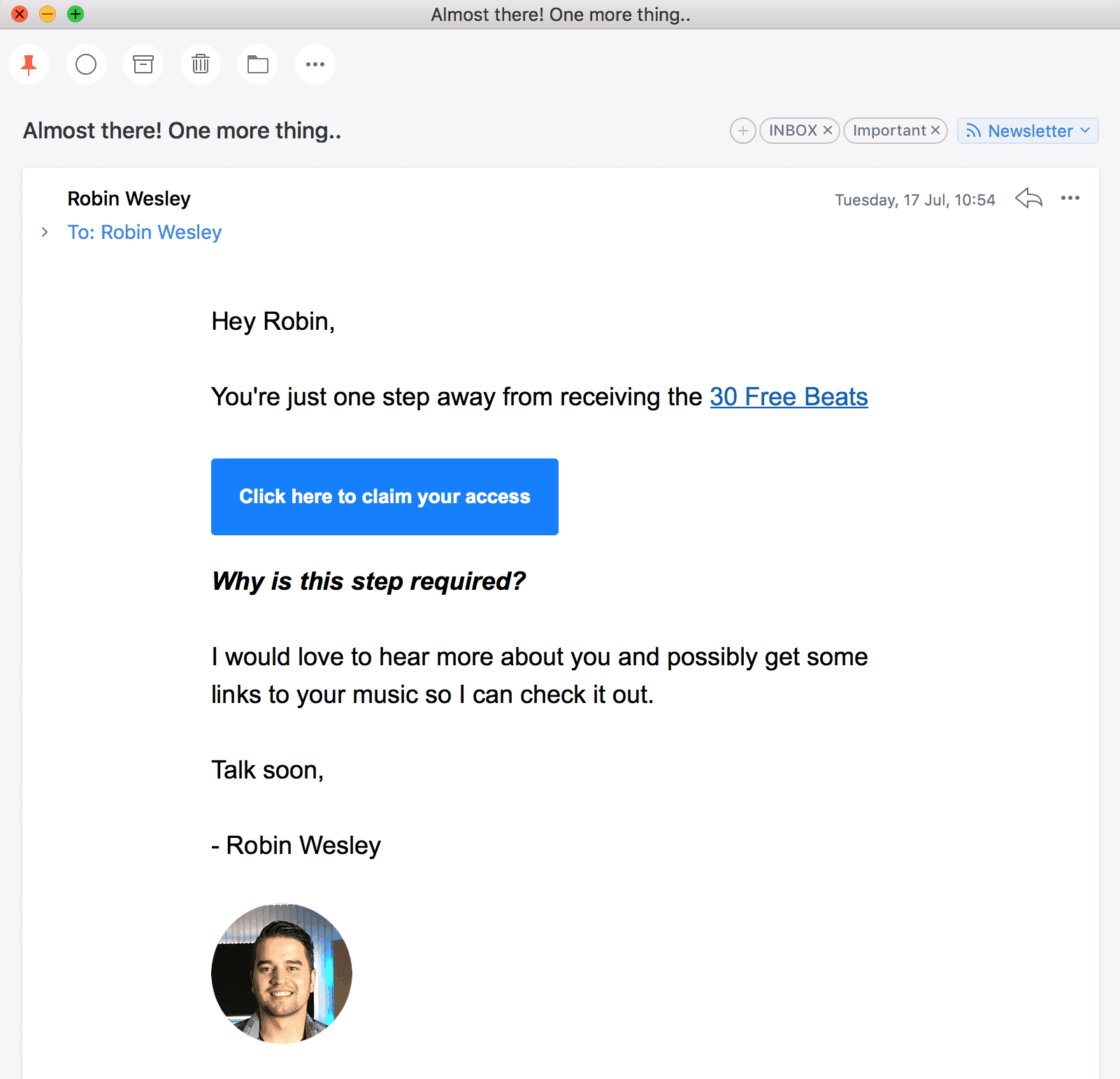
When someone wants to get 30 free beats, they have to go through a mini-survey.
In that survey, they have to answer a few questions. I collect this data in a Google Sheet which I visualize later using Google Data Studio.

This is my way of getting to know the artist that signs up for my mailing list. You can see in the image that I’ve collected enough data to get a clear view on what type of artists I’m dealing with.
A different approach to unsubscribing
Another method I use to maintain a quality list is by offering people to unsubscribe. Every email that’s sent from an ESP has a standard unsubscribe button below the email signature. It’s mandatory.
Still, many producers are trying to hide that button or they try to take it out entirely.
Well, I take a different approach here as well...
In my first email (after the double opt-in/survey email), I give them the immediate option to opt-out of my mailing list. Twice!
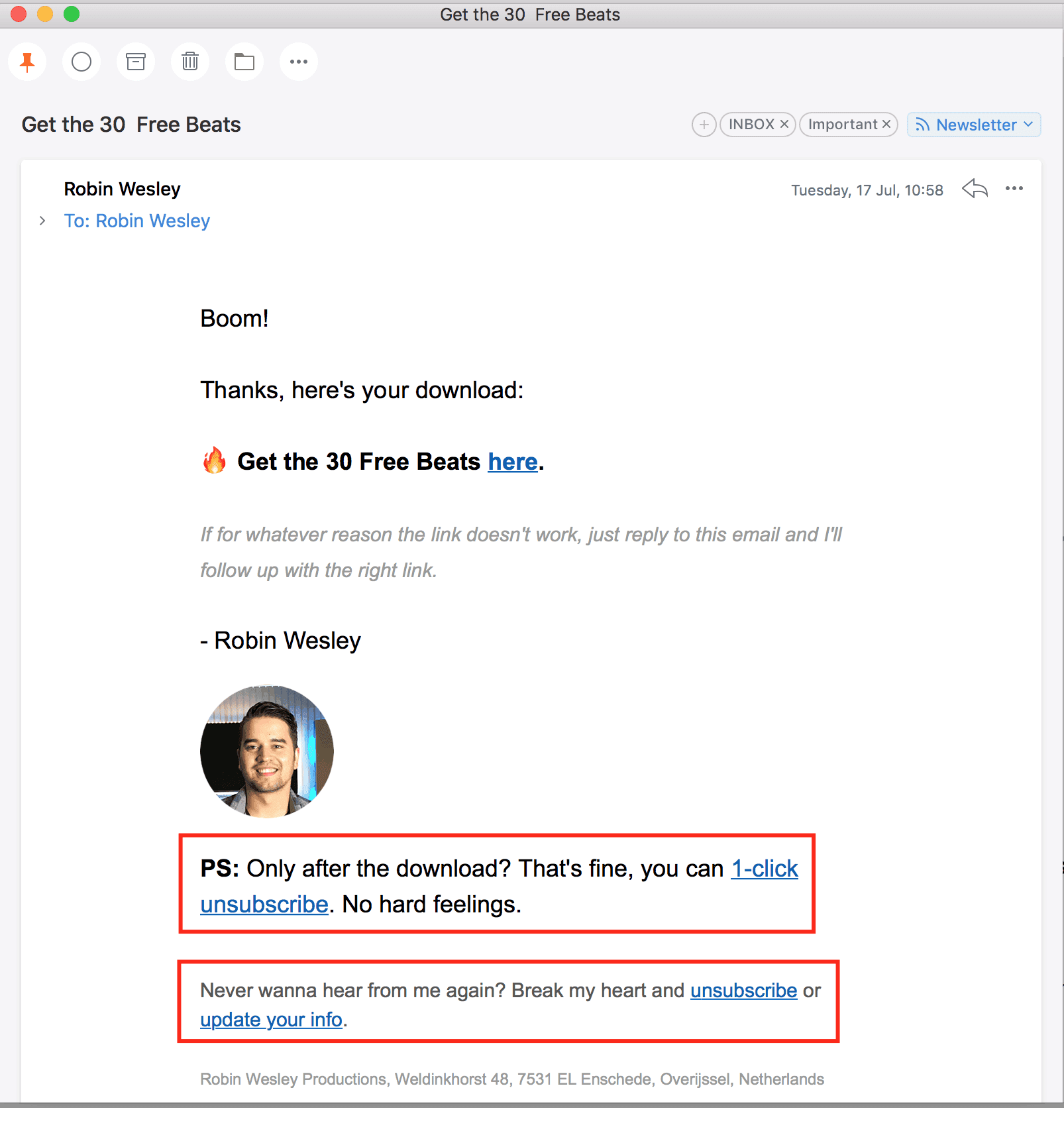
Offer a way to unsubscribe immediately
If they’re only after the download, I rather see them leave and keep a clean list. No hard feelings.
When someone unsubscribes, don’t consider that a bad thing. I used to be almost personally offended when someone unsubscribed from my list. But over time, I learned that these people would’ve never made a purchase anyway.
These days, I’m glad to see someone unsub from my mailing list. That means I don’t have to get rid of them myself if they’ve been on my list for years without making a single purchase.
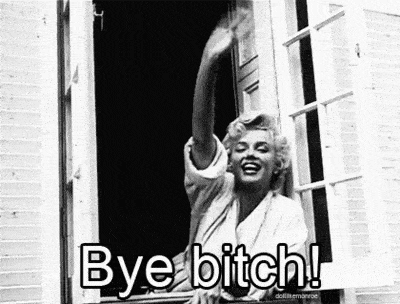
Bounced email addresses
Once you start sending out emails, you may notice that some emails bounce. This can have various reasons. The email can’t be delivered, the recipient doesn’t exist, or the mailbox of the recipient is full.
It’s important that you monitor bounced emails closely and delete the email addresses that keep bouncing. They have a negative impact on the deliverability and success of your email campaigns. In the long term, this can cause serious problems for how well your emails are performing.
Part 4: Copywriting - How to write emails that convert into sales
Writing emails is a skill in itself. And if you’re starting with a blank slate, you probably have no idea how to get started.
Well, here’s what you shouldn’t worry about:
The font and size.
The colour of your buttons or fancy graphics.
The length of the email.
The number of links in your emails.
Presentation matters, but in terms of copywriting, I consider these minor details. When producers write emails, they often overcomplicate the process. And it results in the opposite effect.
No opens, no replies, no engagement and no sales.
There’s no complicated formula to writing emails that convert. Being your plain simple self usually gets you a long way.
To get you started, here are some of the techniques that I use when I’m writing emails.
Tips and techniques for writing emails
1. Be an actual human being
The most important factor for writing emails is to remain an actual human being. Try to write emails the same way you would write to a friend. This includes avoiding unnecessary bold text, capital letters and highlighted or colored text.
There’s a trick that I use to help me with this. It’s called “The Bar Scene”.
For every sentence that I write in an email, I read it out loud and check if that’s the way I would talk to someone in a bar.
Let’s say you’re sending out a one-off campaign to update someone about a new beat release.
In a bar, you wouldn’t come up to me and say…
“2 BEATS UPLOADED YESTERDAY – BUY NOW!”
I’d be like, dude WTF? 🤷♂️
Instead, you’d say something like:
“Hey Robin, I’ve been in the studio all week and just uploaded 2 new beats yesterday. Do you wanna check it out?”
That could actually make me curious and interested in checking it out.
2. Make it personal
With every email you write, you want it to be as personal as possible. That’s why I create segments of subscribers. This makes it easier for me to write personalized emails.
I segment the status of a subscriber.
Segment 1: Lead (hasn’t purchased yet)
Segment 2: Customer
Segment 3: Premium Customer (Returning customers)
I also segment the type of artist.
Segment A: R&B Artist
Segment B: Hip Hop / Rap Artist
Segment C: Other or both
Sending emails based on segments works great for engagement.
This email follows up with everyone that told me in the survey that they’re not an R&B Artist or Hip Hop / Rap Artist.
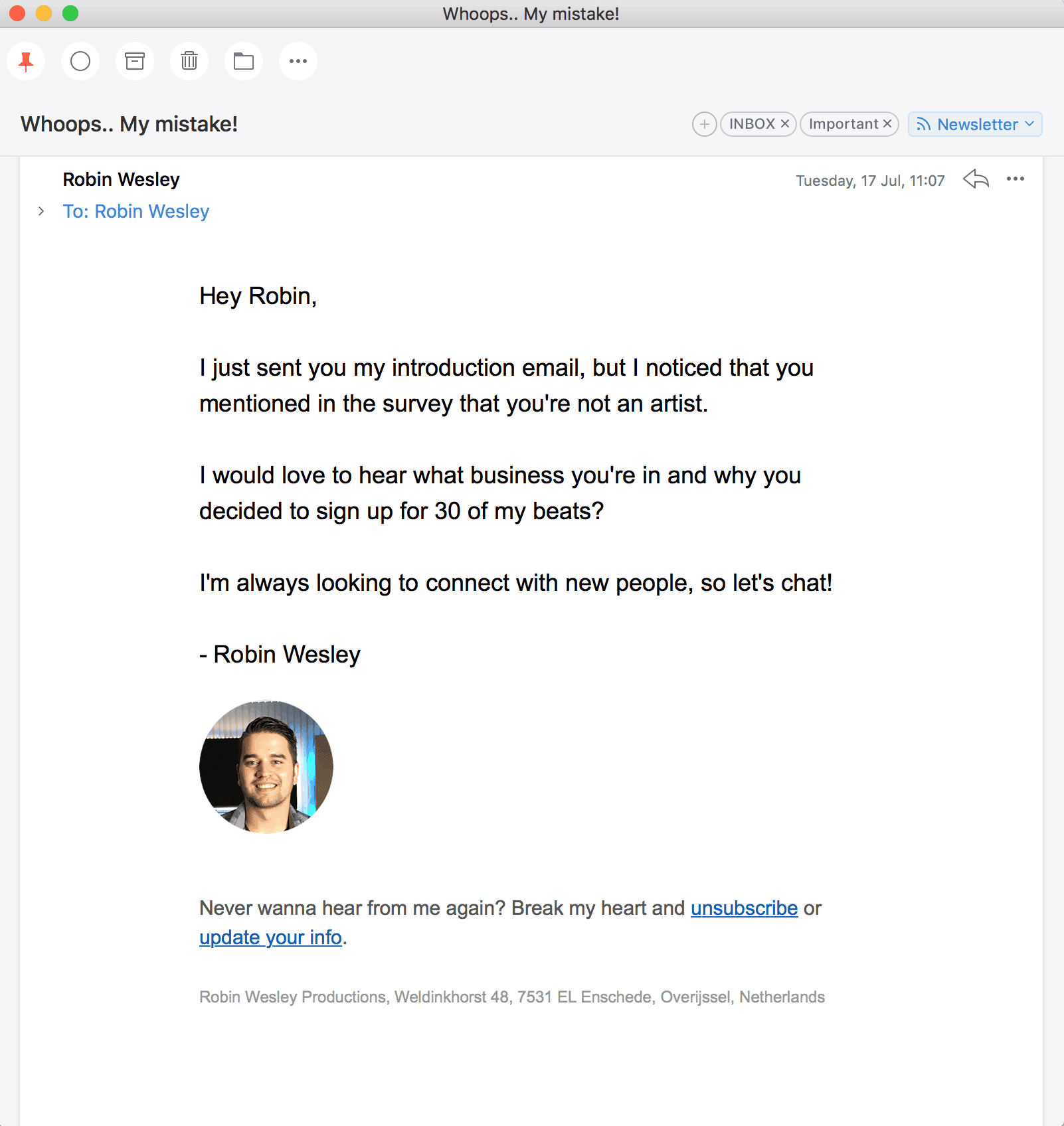
There were many times when an artist actually thought I was sending them a personal email. That is exactly what you should be trying to achieve with every email!
Artists will be more likely to open, read and reply to your emails.
In order to make your emails personal, you need more than an email address. That’s why I ask my subscribers what type of music they create. Their answer puts them in the right segment.
While this is preferable, it’s not critical. But the more information you can collect, the better.
What I do recommend is collecting the first name. I use a lot of ‘first names’ in my emails. I use them in subject lines, in the greeting text and sometimes in email copy.
Most ESP’s provide a way to use ‘custom fields’ to personalize an email with first name, last name etc.
When someone reads his own name, they’re more likely to open and read the email.
It goes without saying that you should never abuse the data you get from an artist. For example, using their first name 6 times in one email is overkill and it will lose its power.
3. Write stories that add a face to the name
How many emails do you receive in your inbox every day? And how many of them do you instantly delete?
Our inboxes are flooded with meaningless junk. And so are the inboxes of your subscribers. So, how do you get someone’s attention?
Definitely not by sending weekly newsletters with new beats.
What you should do instead is tell stories!
People always like a good story. But more importantly, they like to learn more about you and what you are up to.
Here’s an example of telling a short story before introducing my new beats.
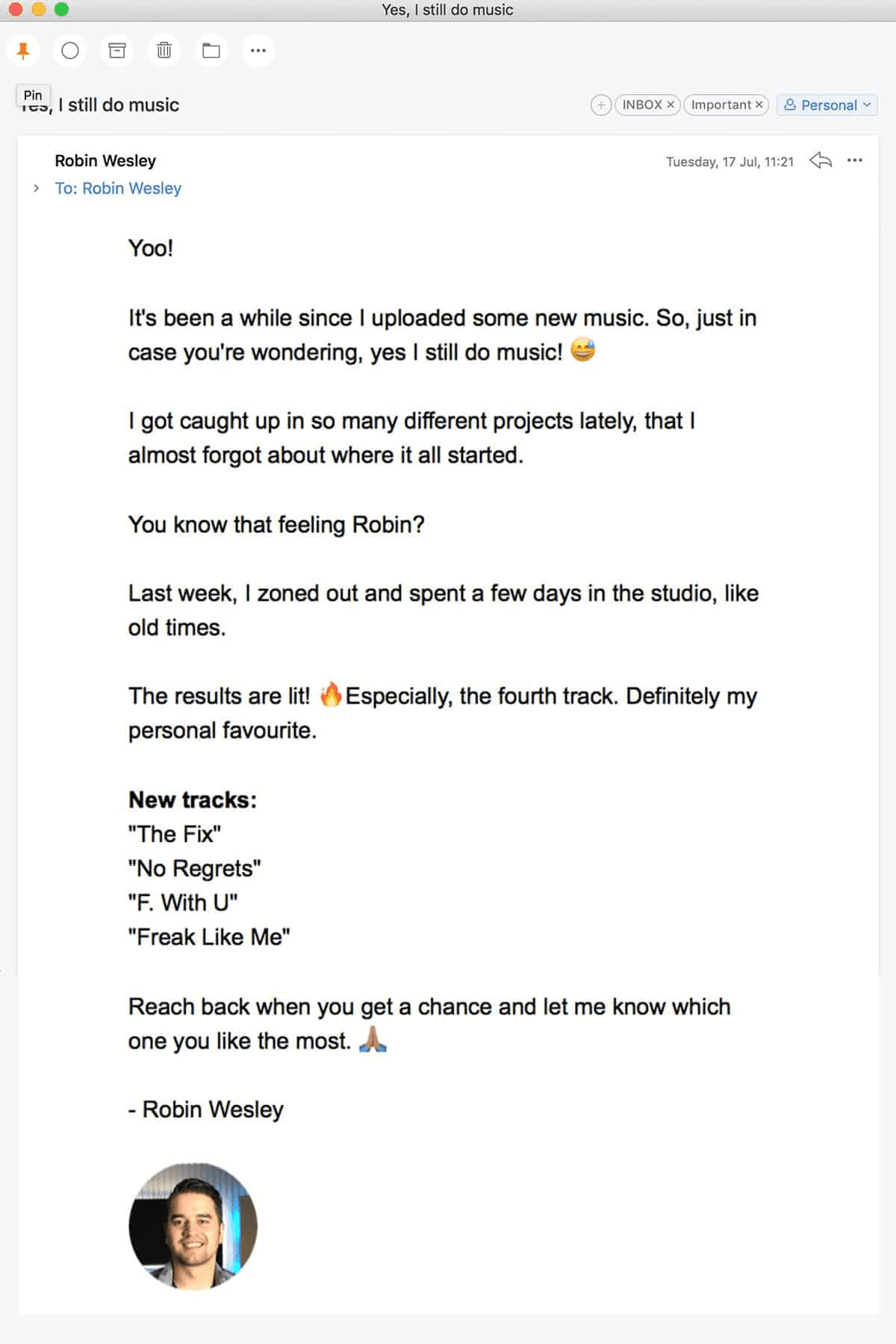
Also, notice my signature in the screenshot above. I add a face to the name with every email I write.
For some reason, a lot of producers hide behind their logos. To be honest, I used to do that too.
But when you add a face to the name, you become a real person. Not just a business that is trying to sell beats.
Mix that with a few personal stories and these artists will start feeling a connection with you.
4. Use paragraphs
I use a lot of paragraphs when I write emails and articles. If you scroll through this article you’re reading right now. You see that I never write 4 or 5 sentences in one paragraph.
This helps to make it easier to read.
No one likes to read an email that’s written as if it’s a page in a book. They usually scan the content in your email.
Without paragraphs, people will have a more difficult time trying to scan. As a result, they get bored from reading it and they won’t get the message that’s in your story.
5. Use casual and personalized subject lines
If you’re sending an email to an artist, you’re one of the 20 other companies that sent them an email that day. So, right from the jump, you need to catch their attention. Your email should stand out in their overcrowded inbox.
You could have written the most amazing story. Perhaps, you’re offering a once-in-a-lifetime deal or whatever offer they simply can’t refuse.
If the subject line doesn’t catch their attention, you get ‘swiped-left’ even before they read what you have to say.
To put this in perspective, most people won’t open your email if your subject line says:
“50% OFF ON ALL NEW BEATS!”
It looks just like any other sales email from Target, Macy’s or Amazon.com.
Instead, you could use something like:
“I have something you might be interested in, [Name}!”
Here are examples of subject lines that worked really well for one-off campaigns to update artists about new beat releases.
“You’re gonna love this, [Name]!”
“Hey!”
“[Name], did you check out my latest beats?”
“I hope I’m not disturbing you, [Name]”
“Long time no speak!”
Notice that these are all casual subject lines. Adding someone’s name to the subject line also helps in personalizing it.
It works much better than using all CAPITAL LETTERS, CamelCase Writing or salesy content in your subject lines.
I should note that you shouldn’t abuse subject lines for the sake of getting them to open the email. It should still somewhat be genuine and in line with the content in the email for the best results.
Deconstructing my Artist Relation Sequence
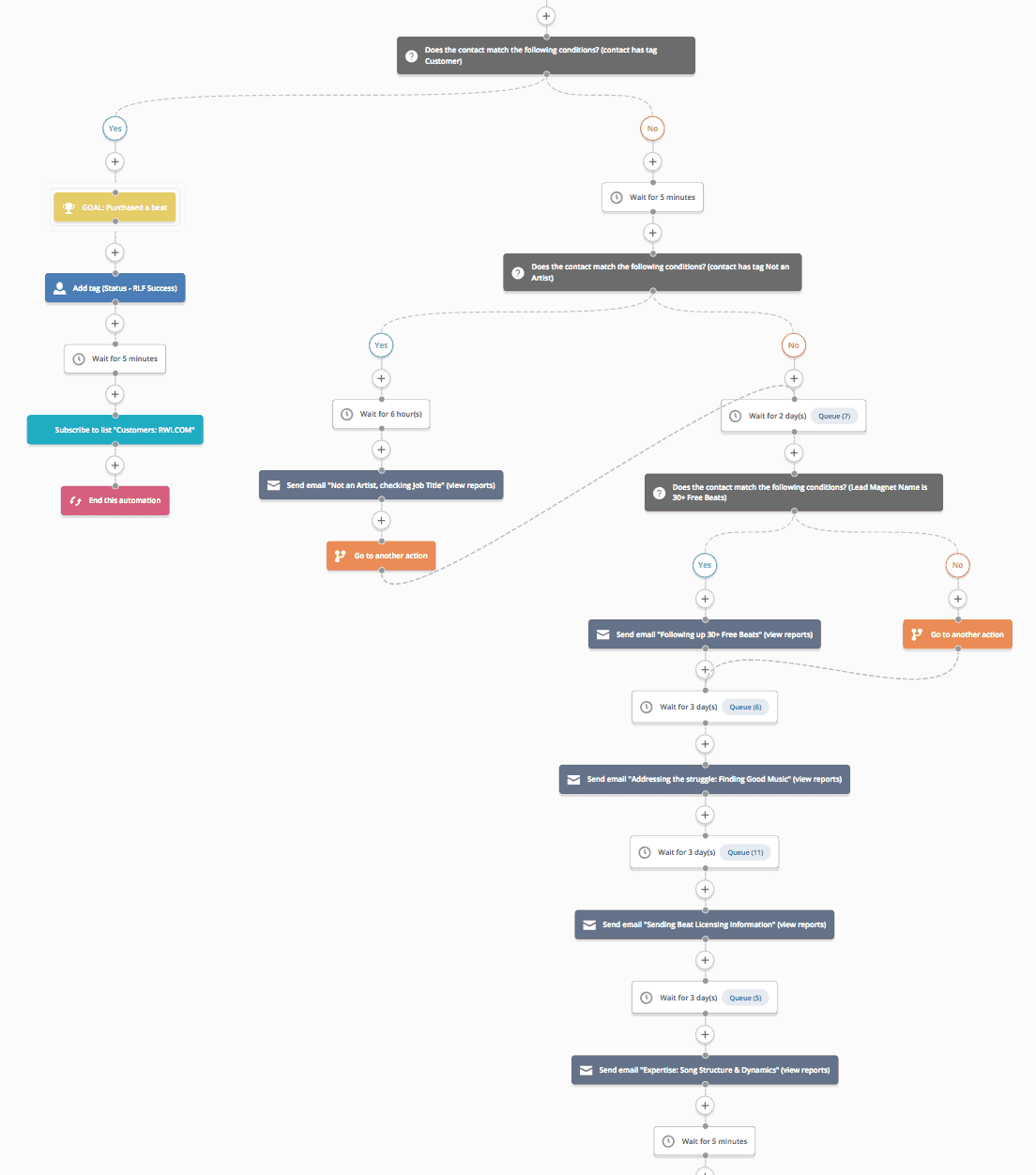
This is an example of one of my automations. During the course of 2 weeks, a lead receives 5 or 6 emails from me. Their journey through this funnel can take a different route depending on their actions or the data that they’ve given me.
For example, if someone tells me that he’s not an artist, he will get an extra email. I simply ask what business he’s in. I showed you this in one of the previous images.
People that told me they’re Hip Hop or R&B artists will take the standard route.
Also, if someone makes a purchase during these 2 weeks. They will automatically get pushed to the left side. (Goal: Purchased a beat)
In that case, there’s no need to send them the remainder of the emails.
The status of this subscriber changes from ‘Lead’ to ‘Customer’. This status-update will automatically put them in a different segment which triggers a new automation. In my case, that’s an After-Sales Funnel.
The goal of my Artist Relation Sequence is to:
Introduce myself
Show my expertise
Give valuable information
Address their struggles
Fix their problems
It’s important to make these emails about them. Not about yourself and absolutely do not send an aggressive sales pitch.
The best way to connect with artists is to shift the focus on THEM!
What do artists want?
What are their biggest struggles?
Which topics peaks their interest?
How can you help them?
What do you have in common with them?
The power of persuasion marketing
I used to work as a Logistics Manager for a multi-million dollar construction company. And every Friday, we had sales meetings with our biggest clients.
My job had nothing to do with sales. I merely attended these meetings to make sure our Head of Sales and CEO wouldn’t make any promises that were (logistically speaking) not realistic.
I absolutely hated these meetings! 😪
For starters, it was always on a Friday afternoon which was the busiest time at the warehouse.
Then there was the fact that half of the meeting was about reevaluating previous projects we did with the client.
And I always came in 15 minutes late. Intentionally, to avoid the 15-minute small-talk that every meeting started with.
Until one day I asked my CEO why these meetings had to necessarily take place on a Friday afternoon. And why it had to take 2 hours to close a deal that, to my perspective, could’ve been closed in 30 minutes.
My mind was blown when he explained it to me.
It was all part of the sales strategy!
The reason why it was on a Friday afternoon, was because everybody is in a good mood when they’re near the weekend. TGIF, right? 🍻It made it easier for him to close the deal.
They took hours evaluating previous projects as part of his after-sales strategy. He wanted to show the client that (even after they had paid) he was still interested in the progress, outcome and success of these projects.
And the small-talk was all part of building a relationship with the client.
He’d ask questions like.
“How are the kids?”
“Did you watch the game last week?”
“Are you taking the boat out this weekend?”
The first part was all about building a more personal relationship with the client.
He also asked stuff like:
“Did you read that article about the government cutting budgets for construction? Is that causing any problems for you?”
“Did you hear about XYZ company going bankrupt? What happened there?”
He used these questions to let the client know that he understands their struggles. Then later in the meeting, he would help them with their problems as part of closing the deal.
He would close a deal like this:
“Well, you know what? Let’s take 10% off and close the deal so we can all go home and enjoy our weekends. I know the cutting budgets impact your business, so this is my way of helping you out. I wouldn’t want to see our best client go bankrupt as well!” *sarcastic*
Ca-Ching! 💰💰💰
My mind was blown!
How I used this strategy to sell beats
I learned later that this is a common strategy used in sales. So I decided to use the same approach to sell beats to artists.
In a lot of my emails, I ask personal questions like:
“Got any plans for the weekend?”
“Doing music this weekend?”
“Working on any new music projects?”
Whenever I’m running a sale, I’m starting and/or ending it on a Friday.
When someone makes a purchase from my beat store. I always follow up on their order to show that I’m genuinely interested in hearing the end-result.
I also send emails with valuable information about topics that they’re interested in. Here’s an example of an email with absolutely no CTA (call-to-action). Just trying to spark the conversation and give value.
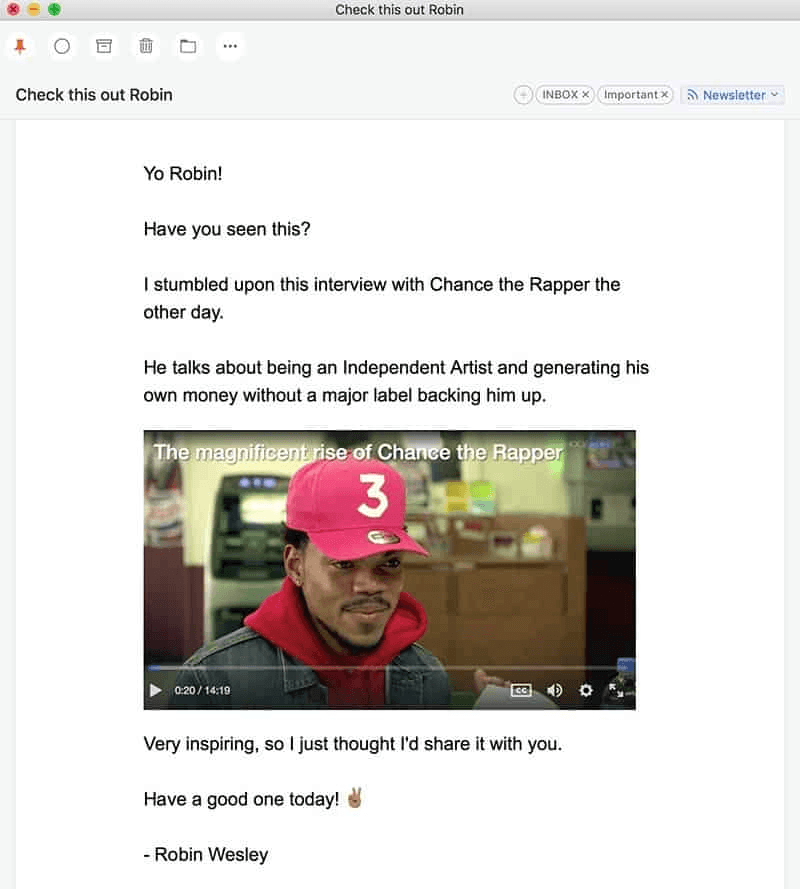
I send this next email to show them that I understand their struggles. Meanwhile, I collect the data from their replies. The answers can be very insightful sometimes.
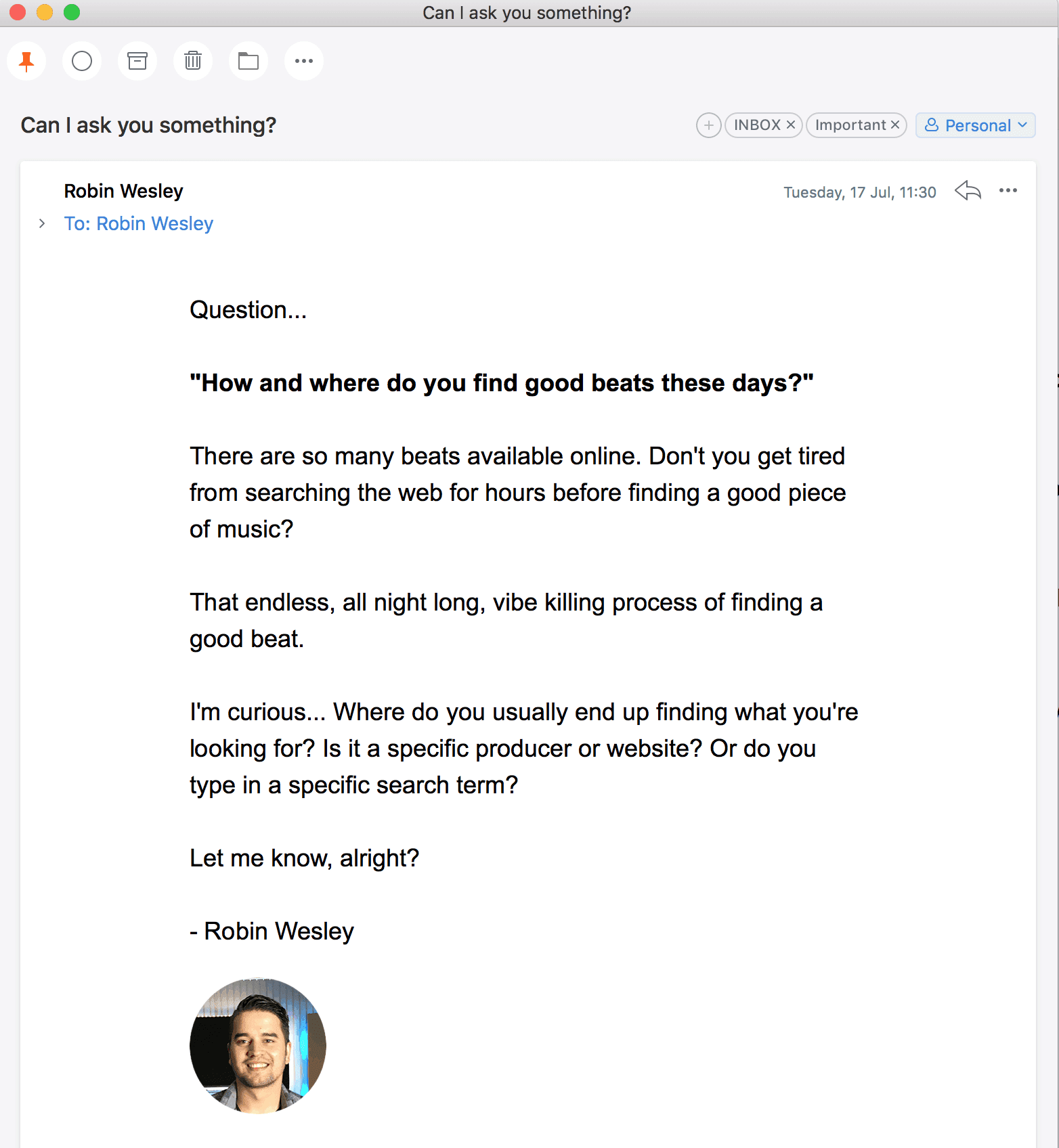
These are just a few examples. Besides this, I also send emails with valuable information to help them become a better recording artist.
I introduce them to Urban Masterclass.
And sometimes I simply ask them to send over their music. I’ll take the day out to give feedback on songs and help them improve their skills.
None of the emails in my Artist Relation Sequence are focused on getting sales.
I shift the focus to them.
How can I help them?
How can I spark a conversation?
How can I give value?
How can I build trust?
By the end of the two weeks. I want them to feel like we are ‘in sync’ and I want them to be able to trust me.
“This guy really knows my struggles, he might be able to help me”
“This guy is a professional, someone who knows his business”
“Wow, I love how he’s so invested in his customers”
Nurturing Leads & Customers
After a good two weeks of sending emails, the artist should get a pretty good idea about what to expect from you. This process is what we call nurturing.
Once you’re done nurturing a lead, you get to a point when they’re ready to receive your (first) offer. This is the moment where they have the highest potential to become a customer.
If you’re lucky, they actually become a customer.
But then the entire process starts over again. Now on a different level.
You can also nurture existing customers. The goal of this is to increase the lifetime value of a single customer.
Instead of buying a single beat for $30, you want them to keep coming back for your beats.
It is proven that the majority of people pay more for better customer experience. Not only do they pay you. They also determine future sales through word-of-mouth and feedback.
Customers provide so much untapped value. Which is exactly why building a relationship with them is critical. It helps you to improve your products and services.
This is how someone replied to one of my emails the other day
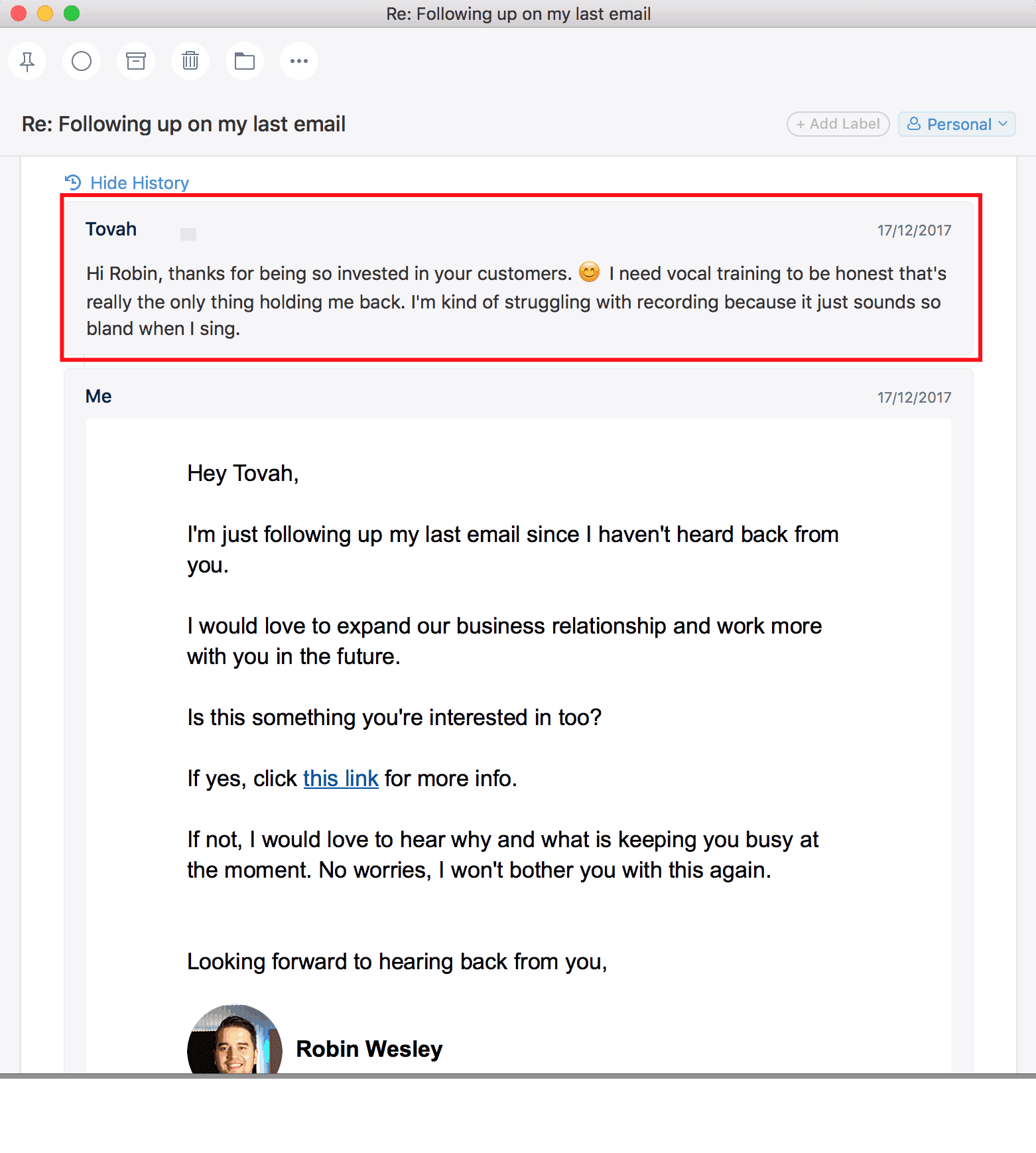
Part 6: How I made over $5,000 by selling an idea
In 2017, we created Zero To Radio Ready. An online masterclass for urban artists, songwriters and producers.
Over the course of several months, I’ve surveyed every artist that wanted to join my email list.
I also emailed my existing customers to find out what it is that they’re struggling with the most. You can see that in the previous image.
I collected the data and used that later to create the masterclass.

Data I gathered from the Survey in the email
The data was so accurate that it generated well over $5,000 USD during the pre-order launch. While I hadn’t even started creating the masterclass! 😀
I just told them the idea and what I was planning to do. I offered a pre-order discount if they signed up within two weeks.
The artists that signed up for it put their trust in me. Trust that I got by building a relationship with them over email. I figured out what they were struggling with and how I could help them with that.
When we launched Zero To Radio Ready, I surveyed the same artists that signed up for it. I wanted to know why they signed up.
I asked them: What convinced you to sign up for my Masterclass?
Here are some of their answers.
“When I email you. You always reply to me and I feel you are a person that’s on top of things trying to get things done. You’re a person so motivated and striving to be the best. That’s who I want to be learning from!”
“I had ZERO doubts. I trust Robin’s work and knowledge and I want to learn every and any last thing possible.”
“I used to be a songwriter and producer so I joined in order to improve my skills. I trust Robin for being the kind of teacher that can help me with this.”
These messages came from artists on the other side of the globe. We’re miles apart. I’ve never had a face-to-face conversation with them. But still, I managed to get their trust. By sending plain-old simple emails.
I'm aware that the example above has indirectly nothing to do with selling beats. But if you look closer, the underlying principles are the same. I send personalized emails. I reply to every single email I get and in the process build massive amounts of trust with my audience. You can do the same!
Be just as creative in marketing as you are in making beats
It’s never been more difficult to direct traffic to your beat site. I also know how frustrating it is to see an increasing amount of traffic coming to your site but no sales follow. This is a regular topic in our Facebook Group “The Art of Selling Beats”.
I started diving into email marketing when I experienced that exact problem. YouTube was and still is a b*tch. Too much competition. SoundCloud, Instagram and Facebook are very time-consuming.
If you’re anything like me. You don’t want to think about posting something on social media while you’re in the studio cooking up beats.
The best thing about email marketing is that you can automate your emails. You can build a relationship with your artists on auto-pilot (ActiveCampaign makes this really easy). You can run a sale on auto-pilot. All while you can focus on making beats.
If there’s one thing that I learned over the years that I’ve been selling beats. It’s that you need to be just as creative in your marketing as you are in making beats.
I sincerely hope that this Producer’s Guide To Email Marketing contains new information that helps you generate more sales.
Make sure to leave a comment below and join our Facebook Group.
ACademy
Join The Academy
Join a hybrid community platform offering music producers a blend of learning resources, expert guidance, industry insights, and networking opportunities.


